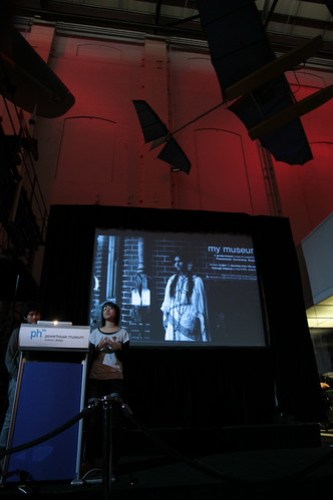Jasper Visser from the Nationaal Historisch Museum in the Netherlands has nailed some of the problems with augmented reality in his recent blogpost – ‘Charming tour guide vs mobile 3D AR‘.
Jasper compares the analogue world experience of a guided architectural tour with the digital experience of using the Netherlands Architecture Institute’s UAR application to plot a similar ‘tour’. This isn’t really a fair comparison but it does raise some serious questions about appropriateness of technology and the kind of user experience we are trying to adapt/adopt/create.
The Netherlands Architecture Institute’s UAR application, built on Layar, is perhaps the best augmented reality application by (or for) a museum I’ve seen and tried thus far. It narrowly beats out the Museum of London’s Streetmuseum – largely because it looks to the future in terms of content as well as in technology.
As I laboured over my presentation at Picnic ’10, the problem with a lot of these augmented reality and mobile apps that museums are doing is that they face a huge user motivation hurdle – ‘why would you bother’? Further, many of the ‘problems’ they try to solve are more effectively/effortlessly solved in other more analogue ways.
Our very own Powerhouse AR experiment with Layar is clunky and honestly, beyond the technological ‘wow’, it doesn’t have a lot of incentive to boot it up that important second time. That might sound critical but needs to be put into the context of it being a) an experiment, b) and having no budget allocation.
Earlier in the year in London I couldn’t get the MOL’s Streetmuseum to work properly on my iPhone 3GS but on my last visit, now with some updates and an iPhone4, I was able to get some serious time in with it.
Streetmuseum has been a brilliant marketing campaign for the Museum of London. It has generated priceless coverage in global media and in so doing associated the Museum of London with the notions of ‘experimentalism’, ‘innovation’, ‘new technology’. And the incorporation of Streetmuseum into the campaign strategy for the launch of the excellent new galleries has been very effective and synergistic.
It has also, demonstrated that there can be an interest in heritage augmented reality – even if it doesn’t quite work the way you’d hope it would.
However, like all these apps – from a user experience perspective the app is clunky and aligning the historic images with ‘reality’ in the 3D view is an exercise in patience. The promotional screenshots don’t convey the difficulty in real world use. As a result the app 3D view, the most technically innovative part of the app, ends up being a gimmick.
However the 2D map view is far more useful and, for the most part, the 2D is very rewarding. And for the committed, walking around London and revealing the ‘layers of history’ can be compelling.
Compared to our the Powerhouse layer in Layar, though, Streetmuseum is, excuse the pun, streets ahead (not surprising given the investment). Streetmuseum’s eschewing of a platform approach of using Layar and building its own system might not be the most long term sustainable strategy but it certainly delivers a far better experience than Layar. Of course, it is such early days in this space that Layar isn’t exactly a long term strategy either.
Mac Slocum over at O’Reilly raises some similar issues.
That’s the problem with app-based AR: even when the app is interesting and the implementation is notable, it’s hard to get people (like me) to use it consistently. AR ambivalence is also tied to the bigger issue of app inertia. A company that pours resources into a custom app doesn’t get much return if that app is rarely launched; the user doesn’t develop an affinity for the brand, and that same user certainly doesn’t buy associated products. The app and its AR just sit there, waiting to be uninstalled.
In my Picnic ’10 presentation I briefly showed the CBA’s Property Guide app. Although this is far from a novel idea (in fact property prices were one of the first things in Layar), the implementation is rather good and points to several things for the cultural heritage sector to take note of.
First it addresses something with a clear existing demand – Australians’ obsession with property prices. Second, it manages to surpass your expectations of the available data – by providing, free of charge, access to ‘good enough’ data for almost every house in the street.
When I first booted up the CBA app I expected to get patchy data for my chosen area. Properties near me sell reasonably frequently but also many people stay in the same place for a long time. So you can imagine my surprise when I was able to see that the last time a place near me sold was in 1984 and for ‘between $30,000 and $40,000’ – as well as every single property up my street. That sort of data usually isn’t available – even in tabular form for purchase.
So how might that play out for cultural heritage AR?
Well, I think for a start it means cross-institutional applications and cross-institutional data. There is no technical reason why the same level of data that the CBA app has access to isn’t available for heritage.
Just thinking of the existing rudimentary ideas about these kinds of apps – the ‘Then & Now’: the local council archives are probably a good place to start and work up the food chain to the big institutions. ‘A photo and a title deed of every property’ . . . . it is only a matter of time.
But addressing the ‘demand’ issue is another matter altogether.








